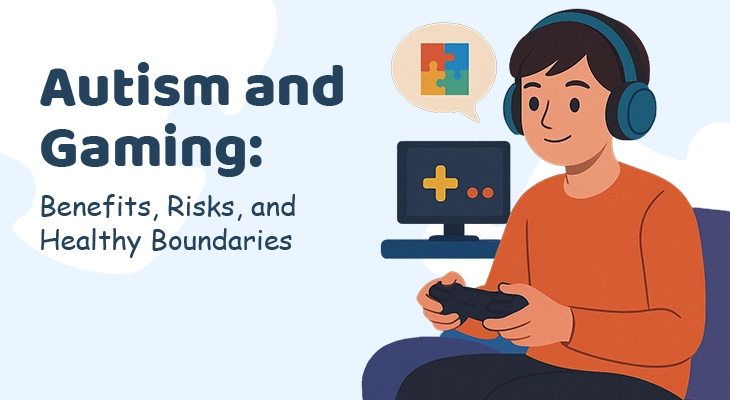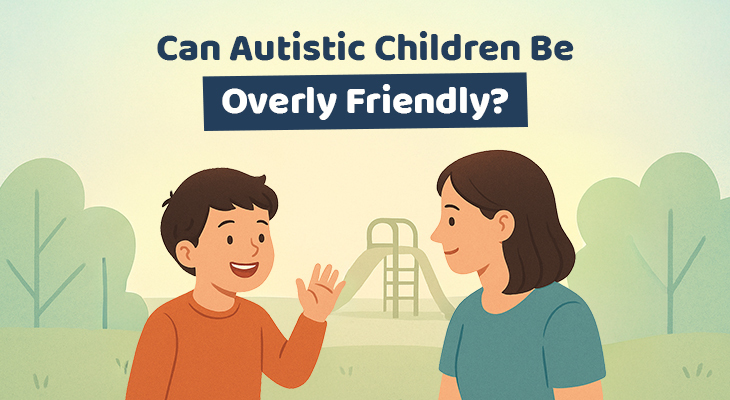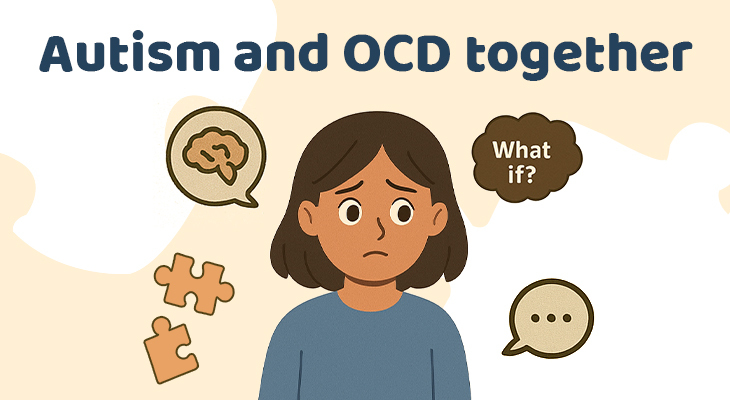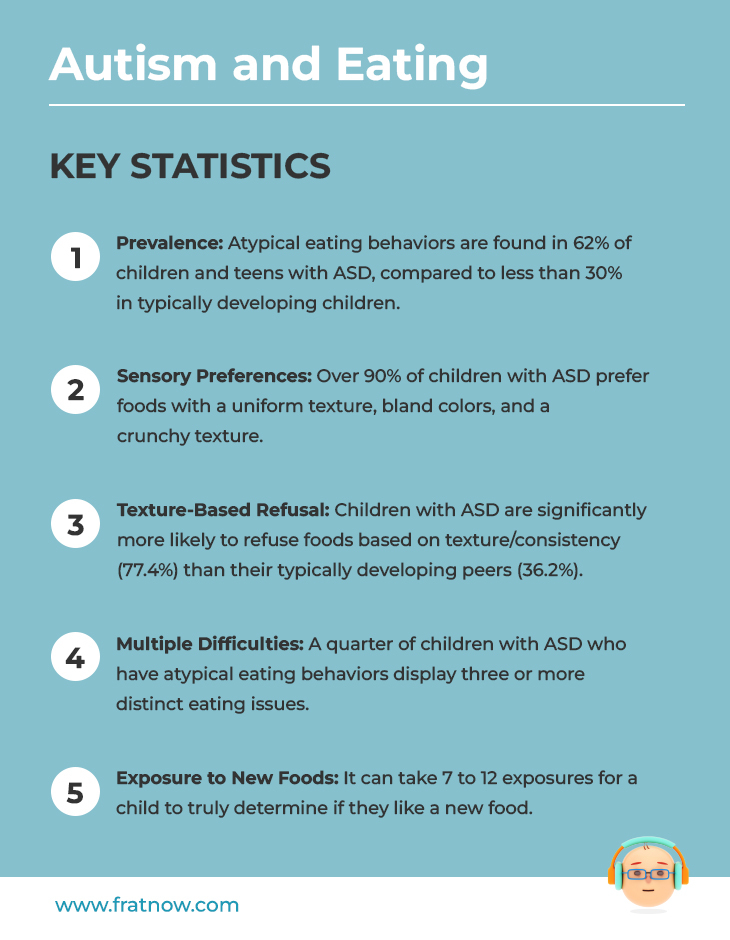
Download Download & share this Knowledge card in your network [Free Download]
Introduction
Hi! My name is Mia. You might remember me from my blog about my sleepy brain. Well, guess what? My brain and my tummy are connected, too! Sometimes, what I eat, how I eat, and when I eat can feel a little bit tricky. It’s not just about what tastes yummy or yucky; it’s about a lot of other things that my brain feels.
My grown-ups say that my brain and body work in a very special way. Because I’m autistic, some things that feel normal to other kids can feel “too much” for me. This is especially true with food. My brain has its own secret rules about eating, and it can be hard to follow them when the world doesn’t.
In this blog, I want to tell you all about autism and food. What makes some foods feel confusing, what helps my tummy and brain feel happy, and why my grown-ups’ patience is the most important ingredient of all.
Why My Brain Has "Food Rules"
My grown-ups say that my brain gets all its information from my five senses: what I see, hear, taste, touch, and smell. Sometimes, my brain feels these senses extra big! When it comes to food, that means my brain has a lot of rules, and if the rules are broken, it feels very uncomfortable. Doctors call this sensory and brain overload, and it’s a big reason why my tummy has so many of its own rules.
And that’s why these things can make eating feel a bit scary or confusing for me:
- Textures feel too weird: Sometimes my mouth feels certain textures in a super-big way. Smooth foods can feel gooey, crunchy foods can feel like rocks, and bumpy foods can feel prickly and wrong. It’s hard to eat something when the way it feels in my mouth is so distracting.
- All my senses get busy at once: It’s tricky for my brain to sort out everything at the same time. For most kids, all the senses work together like a team, but my brain has a hard time with that. This is why a food I usually love can suddenly feel all wrong if it looks a little different or has a different smell than I expected. My brain just can’t make all the information fit together.
- Smells feel too strong: When my grown-ups cook, the kitchen can smell so, so big. Some smells are so strong that I can’t even walk into the room, and it makes my tummy feel a bit sick, even before I eat.
- Loud noises at the table: The sound of forks clinking, chewing, or even just talking can feel so loud that my brain can’t focus on my food. It makes me feel nervous and wanting to get up and get away.
- My brain needs more time: My brain processes things at its own speed, and it sometimes needs extra time to get ready. That’s why I might be slow to try a new food or why a calm mealtime is so important. My brain needs a bit of a pause button to figure everything out.
- A surprise food: When a new food shows up on my plate, it feels like a big, scary surprise. It makes me feel anxious, like I don’t know what’s going to happen next. My tummy feels all tight and nervous.
- My tummy feels funny: Sometimes, my tummy just feels upset on its own, and that makes me not want to eat anything at all, except maybe my most trusted safe foods.
- My body needs to be the boss: My brain loves to feel in control, especially when it comes to food. It wants to be the one to decide what I eat and when. When my grown-ups give me a choice and let me be the boss of my own tummy, it feels safe and happy.
So, grown-ups, please help me understand what’s coming and be patient if my tummy feels a certain way about my food. If you do, my brain might finally feel safe enough to eat!
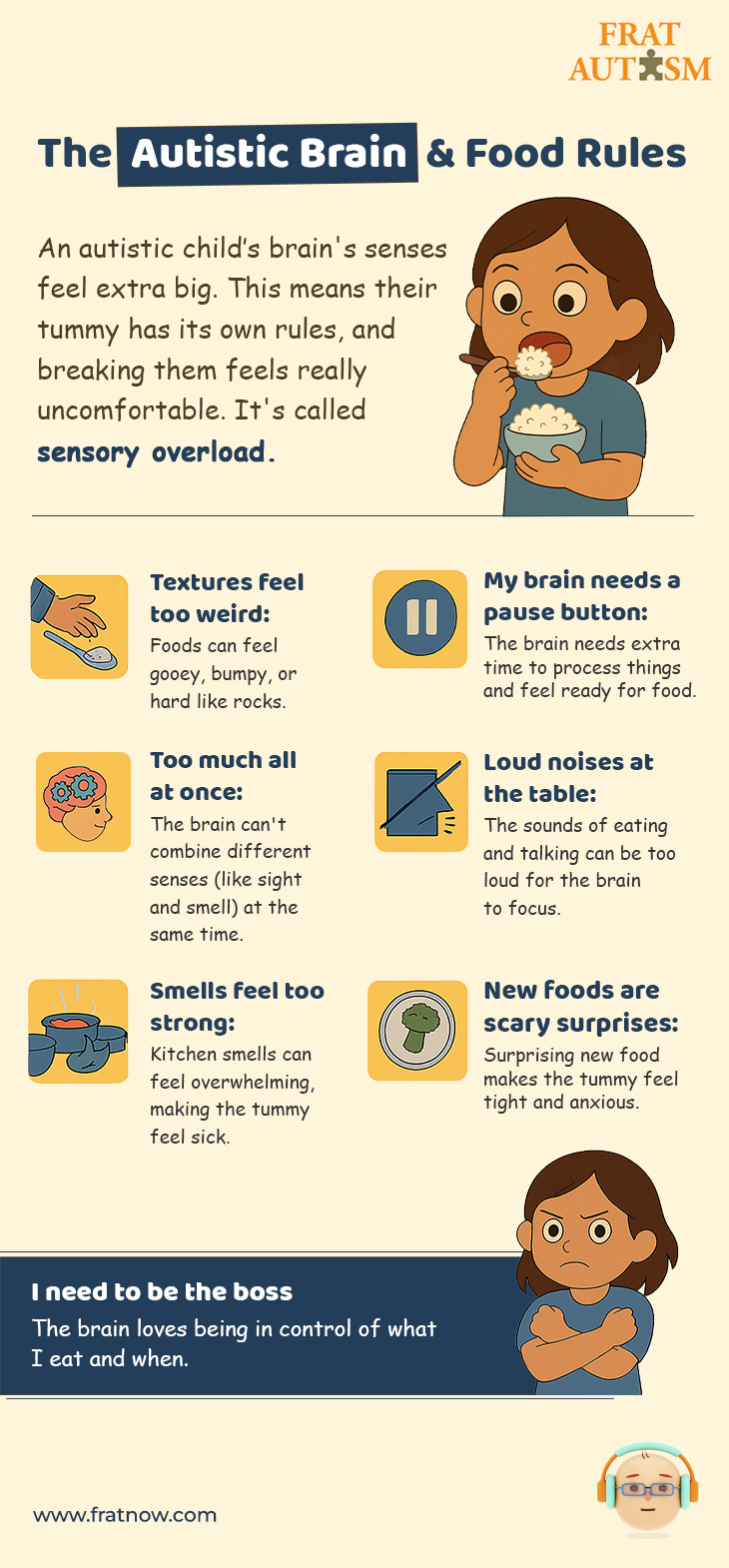
Download Download & share this infograph card in your network [Free Download]
The Tricky Part: My Safe Foods
Even with all my food rules, I have a few very special foods. My grown-ups call them my “safe foods.” These are the foods that my brain and my tummy trust completely. They always taste the same, smell the same, and feel the same.
- Only a few special foods: I might only eat a handful of different things. Even if my grown-ups put a yummy new food on my plate, my brain just won’t let my mouth try it.
- The brand matters a lot: My favorite chicken nuggets have to come in the blue bag. If the brand changes, it feels like it’s a completely different food, and I just can’t eat it, even if it looks the same.
- It has to be just right: My food can’t touch on the plate, or I can only eat the white part of the macaroni and cheese. If a rule is broken, my tummy feels upset and I won’t eat.
It’s not that I don’t want to try new things; it’s that my brain just feels like it’s taking a big risk with my tummy!
My Special Mealtime Helpers
Even when eating feels a bit tricky, my grown-ups and I have found some really good mealtime helpers. These are the things that make my tummy and my busy brain feel safe and calm enough to finally eat:
- My predictable food map: Just like with my sleep map, my mealtimes feel best when they are the same every day. We eat at the same time, at the same table, and I use my special plate.
- No surprises: It helps when my grown-ups tell me what’s for dinner ahead of time. I can even look at a picture of it. If there’s a new food, they let me choose if I want to have it on my plate or just look at it from a distance.
- Sensory-based helpers: Sometimes, my special chewing toy helps me get my mouth ready for different textures. Having a soft cloth to hold or a special seat also helps me feel calm at the table.
- A quiet table: My grown-ups try to make mealtime quiet and peaceful. If I can’t talk at the table, that’s okay! We don’t have the TV on, and all the sounds are gentle.
- Special helpers who understand my tummy: Sometimes, a special helper called a feeding therapist or a dietitian helps my grown-ups learn about how my brain and tummy work together. They know all the secrets to helping kids like me feel comfy with food.
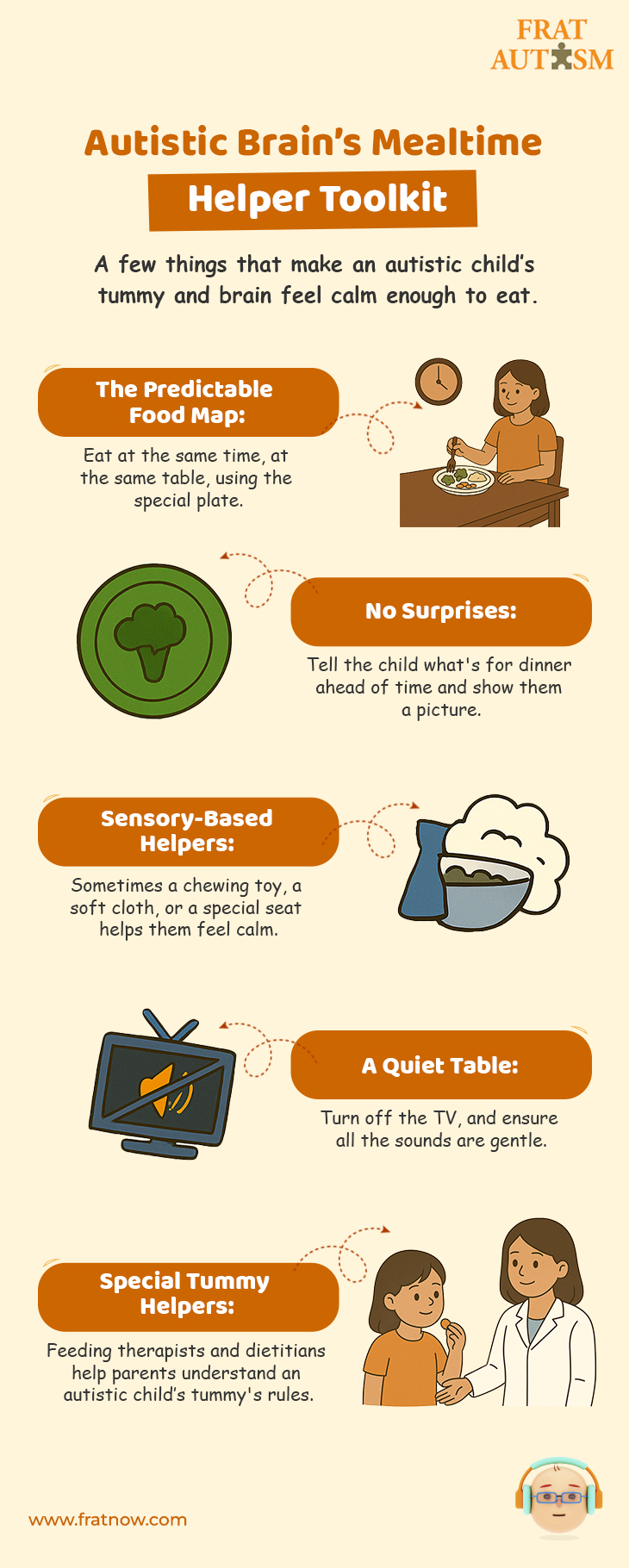
Download Download & share this infograph card in your network [Free Download]
My Grown-Ups' Special Helpers
My grown-ups are learning even more special ways to help me with my food rules. They call them techniques, but I just think of them as my grown-ups’ special helpers. They are all about being super, super patient and helping me feel safe enough to try new things.
My brain has a very big rule about new food: it’s a bit scary and my tummy feels nervous about it. My grown-ups call this neophobia, which just means a fear of new things (or food). To help me, my grown-ups found a special helper called Starting Small. If they want me to try a food I don’t know, they give me a bite that’s so tiny, it’s like a speck on my plate. It makes the new food feel a lot less big and scary!
And the best part is the “no thank you” bite. After I take the teeny tiny bite, I can say “no thank you,” and I don’t have to have any more. It’s a rule that my brain understands, and it helps me know that the new food isn’t a true threat. This feeling of being in control of my plate makes me feel so much safer.
They also have a secret rule about talking to me at the table. For every one time they have to remind me to do something, they try to say five nice things. So they say things like, “Thank you for coming to the table, Mia!” or “I love how you used your fork!” They call this Labeled Praise. It feels really good to know exactly what I did right.
And sometimes, when I get super upset about a food or a noise, they don’t get upset back. They just look away and act calm, as long as I’m safe. My grown-ups call this Planned Ignoring. It’s a special way for them to show me they understand that my brain is having a hard time, without making a big deal about it. It helps me calm down much faster.
These helpers make me feel like my grown-ups are on my team. They’re trying to meet me right where my brain is, and that helps me feel understood and brave enough to try again tomorrow. [1]
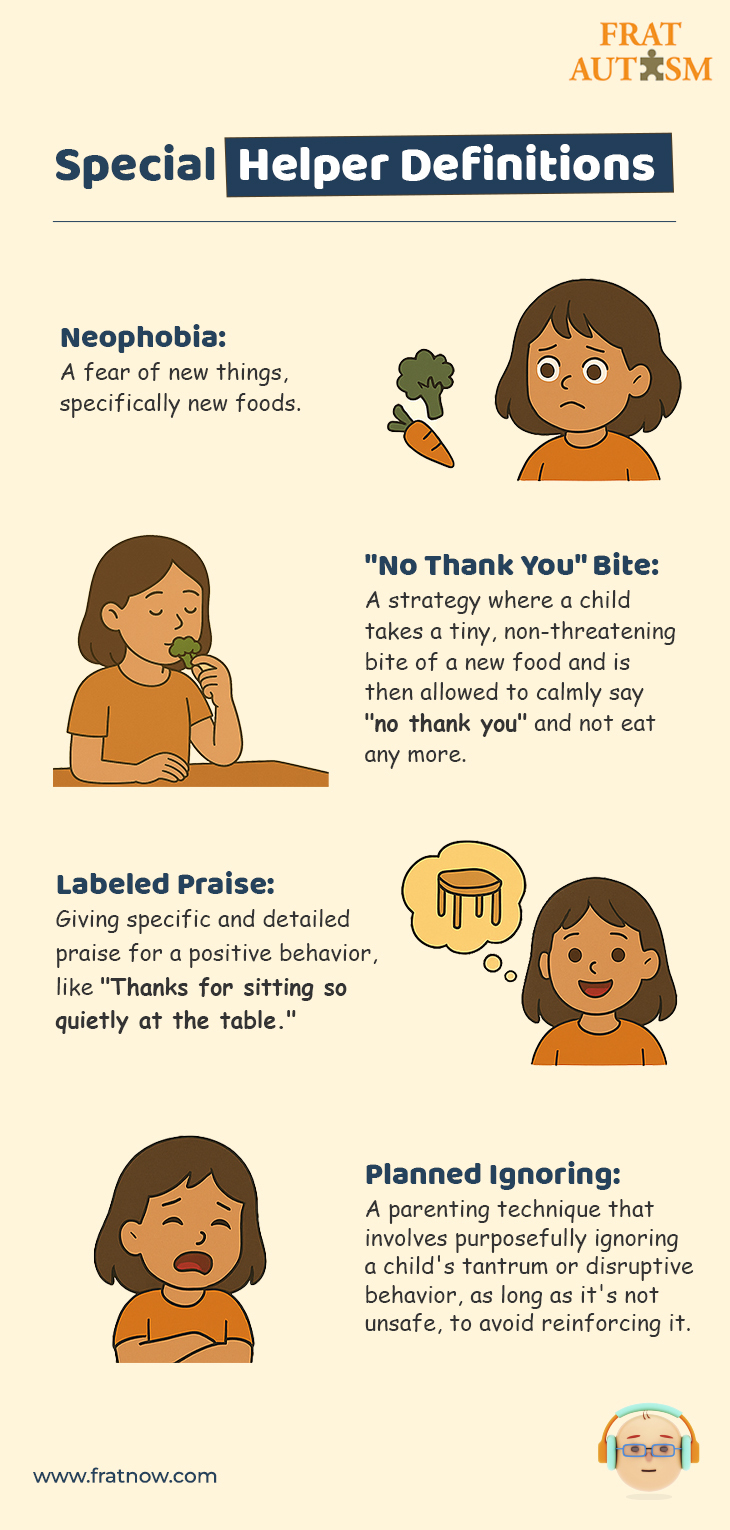
Download Download & share this infograph card in your network [Free Download]
My Wish for Grown-Ups
So, that’s my story about food. It can be tricky, but it’s a very important part of my day. My biggest wish for grown-ups is this:
- Please understand it’s not my fault when I can’t eat something. My brain just works a bit differently when it comes to food, and sometimes it needs extra help to feel safe.
- Thank you, thank you for helping me find all my special mealtime helpers. Because more than anything, I just want to feel happy and healthy like other kids, ready for all the adventures of the next day.
Conclusion
Thank you for listening to Mia’s story about food and her unique world of eating. Her brave and honest words help us see that what might appear as defiance or “pickiness” is truly an intricate dance between a autistic child’s senses, their need for predictability, and their overall well-being.
As adults, truly understanding the intricate connection between autism and eating isn’t possible without stepping into a child’s unique world. We hope Mia’s story offers invaluable insights, fostering deeper empathy and equipping you with practical ways to support the precious health of the autistic children in your lives. Every bite taken in peace contributes to a brighter, more engaged day, helping them thrive in their own wonderful way.
FRAT® Test - Key Facts To Know
Of the 20,000+ individuals tested with the FRAT® test, a significant percentage showed positive results, indicating the presence of Folate Receptor Autoantibodies. Supplementation with alternative treatments like folinic acid has demonstrated improvements in quality of life for many of these individuals.
A FRAT® user’s TikTok video, sharing her child’s positive transformation following a positive FRAT® test result, went viral. Since its posting, the video has garnered an impressive 800K views, 79K likes, 27K shares, 33K bookmarks, and over 3K comments. Watch the video below:
@kyra2532 LIFE CHANGING updates for children with autism. #autismmom #childwithautism #autismresearch #autismfamily ♬ original sound - Kyra
Note: This video is only available in
regions where TikTok is available.
Over the years, more than 1400 physicians have been prescribing the FRAT® Test, underscoring its growing recognition as a valuable diagnostic tool.
Here’s what Maxwell (Parent to an autistic child) has to say about the FRAT® test:

MAXWELL M.
References
- Child Mind Eating, Autism & Picky Eating
- Science Direct – Eating behavior in autism: senses as a window towards food acceptance
- National Autistic Society – Eating – a guide for all audiences
- International Journal of Clinical Pediatrics – Feeding Behaviors Among Children With Autism Spectrum Disorder

